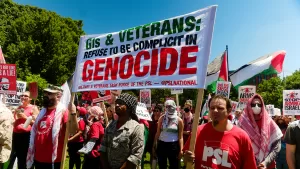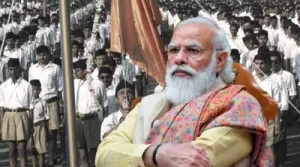My father was wounded as a marine in savage and ruthless combat in the Pacific during the “Good War.” He carried PTSD to his grave. On the day after the Japanese “sneak attack” at Pearl Harbor he dropped out of high school and enlisted thinking to revenge what our culture insists was a cold-blooded sneak assault. Eight months later, barely 18, he was on the island of Guadalcanal engaged in vicious bestial combat the realities of which most Americans know nothing.
My relationship with him was very difficult but I enlisted in the Marine Corps myself at the tender age of 17 in 1965 seeking to prove my “manhood” to him as a defender of American freedoms just as I believed he had done. Of course, I had no realistic idea what I was getting into but my decision was fully informed by the mythologies of the day about the presumed nobility of the role the U.S. played in liberating the world from Japanese militarism and Nazi horror.
I was a troublesome teenager, hated the conditions and rules of society, and I had been given a choice by a local judge either to face charges or to have them dropped if I enlisted in one of the armed forces (this was a commonplace recruiting method in the Corps at the time.)
My military experiences turned me eternally against the monstrosity of war and militarism and propelled me on a quest to understand the wars of America. This article is a basic summary of the U.S-Japanese War after a lifelong inquiry into the realities of American entry into World War II.
How many citizens can identify Millard Fillmore? This almost indiscernible 13th president served from 1850-1853, initiating an almost century-long process that ultimately set in motion the 20th Century war between the U.S. and Japan. In 1852 Fillmore dispatched Commodore Mathew Perry to “open” Japan to American trade. A decade earlier the British had initiated the “Opium War” in China as a means of weakening it from within, then seizing Shanghai and Hong Kong as first stages for greater acquisition. In America, the Industrial Revolution was fully under way and building steam. Investment and banking capitalism was developing rapidly and gaining more power within the American government. American bankers and industrialists perceived that Europeans had entered the larger “Great China Market” by force, and they ardently wished to follow suit. The requisite ports were stolen from Mexico in the 1840s and Japan was seen as the next step. Western Europeans and Americans viewed Africa, Asia and South America as rich with opportunities to exploit resources, labor and markets for the profit of their ever-expansive economic systems.
We know that European-Americans largely viewed non-white peoples as inherently inferior and so U.S. officials viewed Japan as a backward, primitive society ripe for exploitation but the greater target was the much vaster East Asia and Japan’s ports could expedite that goal.
In 1852 Perry sailed what the Japanese still call “The Black Ships” into Edo harbor, today Tokyo, and demanded a meeting with the highest officials. Japanese were alarmed and refused. He then threatened force, shooting some cannon bursts onto a small uninhabited island in order to impress the potency of the navy’s modern firepower. At that stage Japanese society, and its armed forces, might be compared to late Medieval England. Japan’s shogun capitulated and under duress agreed to the inception of trade between the two nations and American use of Japanese anchorages. The successful Perry then counseled Congress to secure naval bases throughout the Pacific, the most strategic being Hawaii and the Philippines, which the U.S. subsequently seized by the end of the century. The U.S. promised the native Filipinos independence from Spain but instead recolonized them for American strategic interests aimed at further encroachment into Asia. The guerrilla war mounted against the American occupiers by Filipinos paralleled the future war in Vietnam in its widespread atrocities.
Now the Japanese perceived the degree to which Europeans were inserting themselves throughout Asia: they saw that the British were in India, the French in Indochina, the Dutch in what is now Indonesia, and the Portuguese in Macao. Given its weakness, Nippon had solid reason to believe they were next. The result was a complete transformation, top to bottom, of Japanese society and especially its military. The new rulers of a reconstituted imperial system now reasoned that to avoid the fate of other Asians they would have to become and act like the Europeans and Americans who threatened them and by the turn of the 20th Century the Japanese had mastered Western-style military tactics, defeated Czarist Russia taking parts of Siberia, occupied some of China, adopted and adapted capitalism to their desires. Then they began to strengthen themselves by accessing resources, labor, and markets, exploiting other peoples, just as the Westerners were doing. They had become competitors in the “Great Game” of power as the British dubbed it and that meant the possible closure of American opportunities.
In the late 19th Century the Chinese imperial system was collapsing and Europeans, Japanese, and Americans all rushed to seize and control various areas of China. Young Chinese students were rebelling against these takeovers by these foreigners. They called themselves the Society of Righteous Harmonious FISTS – hence the uprising was dubbed the Boxer Rebellion. The U.S., Europeans and Japan all sent troops to crush this insurgence.
Most Americans know little if anything about this bloody episode. We can be certain that the Chinese have not forgotten. If the Chinese had ever invaded the U.S. our children would learn that on the first day of the first grade.
In that same year, the U.S. issued the “Open Door Notes” arguing against the carve-up of China in favor of open Western access to its riches on equal terms for each and all. The U.S. knew it had every advantage since it had the most rapidly growing economy in the world. For that matter its rivals did too and tried to seal separate colonies closed to all other contenders. Let me state categorically that while the term is rarely used today the Open Door Policy continues to be the overarching and bedrock goal of American foreign policy. When Washington speaks of the “rules based international order” today it means that the world’s resources, labor power and markets must be open to American corporate and financial enterprise on American terms, a global capitalist system beneficial primarily to American investors and the rulers of those nations that cooperate with the American agenda. The United States will go to war to ensure this policy as it has demonstrated time and again across the planet from 1898 to the present.
Westerners soon lost the footholds they had in China when they began to slaughter themselves in World War I thus leaving the path fully open to Japan. Believing that its only defense against western predation was to become a predator itself Japan moved to dominate its part of the Pacific and East Asia as the U.S. controlled much of the Western hemisphere. But the success of such an upstart would close the U.S. out.
By the 1930s the Great Depression had reduced American economic production almost to a standstill. American oligarchs still controlled the nation’s wealth but were not investing in an economy with far fewer consumers, and markets rapidly closing, so the majority of citizens suffered deeply and the political system was rocked to its roots. American capitalist production had to find new outlets. With millions unemployed the nation was politically divided and dangerous instability loomed. Enormous international obstacles to the export of U.S goods and capital had taken shape. The “communism” practiced by the USSR already stymied new outlets in that vast territory, and then the takeover of Central Europe by Nazi Germany closed much of the continent.
Meanwhile Japan was ruthlessly taking over much of China and East Asia. Thus the U.S. was economically isolated; all but the Western Hemisphere was closed to American trade and investment and in South America depression also limited trade there. Germany had made deals with some nations on that continent that also thwarted U.S. corporate desires. Solution: In words spoken later by the CEO of the General Electric Corporation, the country needed “permanent production for permanent war” (appear familiar?) Sixteen million unemployed would soon fill the ranks of the U.S. military.
My point here is that Japan’s subsequent takeover of Korea, Manchuria, and the British, French and Dutch colonies provided the real rationale for the American desire to war against Japan not the attack on Hawaii. That was merely the spark and that catalyst had been craftily and dishonestly fostered to bring war about. Japan was obstructing the American goal to access the riches of China.
Prior to outright war in 1941 the U.S. had cultivated and armed those who came to be known as the Nationalists in China and American pilots were carrying out attacks on Japanese forces, in outright violation of Congressional law stipulating American neutrality.
The ruling Japanese saw this as an obvious precursor to full-scale war with the U.S. Tokyo believed that it must strike first where it could deliver a significant blow to the American navy and give itself more time to build defenses. The target could only be Pearl Harbor.
In 1938 President Roosevelt moved the U.S. Pacific fleet from San Diego to Pearl Harbor and built-up naval force in the Philippines within striking distance of Japan, and later embargoed oil and steel critical to Japan’s overall economy and its effort to subdue China, and demanded full withdrawal from Southeast Asia. At the same time the U.S. Navy deliberately entered Japanese waters in order, it was hoped in Washington, to provoke a Japanese attack that would overcome majority American opposition to another war. During his fourth campaign for the presidency Roosevelt falsely promised as follows:
“…while I am talking to you mothers and fathers, I give you one more assurance. I have said this before, but I shall say it again and again and again: Your boys are not going to be sent into any foreign wars.”
While the focus of this article has been on the U.S-Japanese side of the war a few words must be said about the issue of Germany. The Nazi takeover of much of Europe posed the same threat to longstanding plutocratic desires for a global order beneficial to American capital as Japanese control of East Asia. Seeking to deter the U.S. from entering the ongoing wars in Europe and Asia Germany and Japan had entered into a defense pact known as the Axis Alliance ( transmogrified today in relation to current “threats” as “the Axis of Evil).” Though Congress had mandated law requiring neutrality in the ongoing war in Europe it allowed Britain the loan of naval vessels under the “Lend-Lease” program. Secretly and dishonestly FDR had ordered the Navy to convoy and militarily protect these ships and commercial vessels to England. On a number of occasions the Navy depth-charged German vessels attacking British ships. In every incident FDR told the American public that these events were unprovoked attacks by Nazi Germany. Five weeks before the attack at Pearl Harbor the American destroyer, U.S.S. Reuben James, was sunk with the loss of 100 lives. Despite whatseemed a golden opportunity Roosevelt did not use the sinking to whip up frenzy for war because FDR knew the ship was not flying the American flag (though Germany knew that it was a U.S. vessel violating American claims of neutrality). Had the truth been revealed it was highly likely that other duplicities about the U.S. engagements in the North Atlantic would have been divulged. Most honest observers at the time concluded that FDR was seeking a front or back door to war. Hitler declared war on the U.S., he said, because of these American provocations.
The Roosevelt Administration was fully aware that the American public, sick at the losses of American life during World War I, and aware of congressional investigation into flagrant corruption by the arms brokers, or “Merchants of Death,” wanted no war. But Washington reasoned that if they could push and then wait for the Germans or Japanese to attack first the public would be outraged and war would necessarily ensue.
December 7, 1941 was no “sneak attack.”[1] The Japanese hoped it would be but Washington, and London cryptographers had broken key Japanese radio transmission codes and knew that the Japanese government had taken the decision for war and that Japan’s fleet was moving toward Pearl Harbor. The Navy had been ordered to clear all traffic from the seas to the west of Hawaii so as not to be in a position to forewarn the Japanese fleet. The Naval commander in Hawaii, Admiral Kimmel initially ignored this directive but he was then ordered to send the ships back to Pearl Harbor where they were sitting-ducks.
Another high tech espionage tool of the day-Radio Direction Finders-tracked the fleet across the Pacific. Thus, while a general warning was issued to all commanders that war was imminent in the Pacific no specific warnings were given to either to naval or army commanders in Hawaii even though Washington knew with certainty that the Japanese Fleet was steaming toward Pearl Harbor. The 2400 Americans killed that day were pawns in the deadly and utterly stupid chess game that continues to this day.
Everyone knows how the war ended. Few know that the Atomic bombings were not militarily necessary. After the world’s first nuclear weapon was successfully detonated in New Mexico in mid-July 1945 Washington demanded “unconditional surrender” from Tokyo. Japan knew it was defeated and wished to end the war without American military occupation of its territory so it refused to capitulate. The standard interpretation of the decision to use the Bomb is fixed on the claim that many thousands of American troops would die in an invasion of Japan but military planners knew that such an incursion would not be possible until November at the earliest and perhaps not until March of 1946. Meanwhile, the Soviet Red Army, the prime military force that defeated the Nazis in Europe (Frankly, the U.S. could never have defeated Germany on its own), had entered the war against the Japanese in East Asia and was quickly overrunning Japanese defenses including on Nippon’s outer islets. If the American invasion of Japan’s home islands was paralleled by a Soviet invasion the Post-War arrangement in Asia would have become as critical and dangerous as the division of Europe that led inexorably to the Cold War. The Atomic bombings of Hiroshima and Nagasaki ended the war before the Soviets could occupy the Japanese homeland and led to the immediate unconditional surrender of Japan. The bombings also were intended as a warning to the Soviet premiere, Stalin, that the Americans could be as ruthless as himself. That, in turn, accelerated the USSR’s desire to match Washington in the nuclear arms race.
I’m sure that any reader would agree that war has characterized Homo Sapiens Sapiens for millennia and that it is obvious that war has become ever more destructive to the point that a nuclear war would mean self-extinction. I am aware of no other species so blind and dim-witted as to bring about its own species’ annihilation. Yet, as I always tell students, “As long as nuclear weapons exist sooner or later they will be used.”
Notes
[1] For a comprehensive precis of the scholarship on the Pearl Harbor attack see Jeremy Kuzmarov, “Eighty Years of Lies…,” CovertAction Magazine, December 7, 2023.
(Paul Atwood is the author of ‘War and Empire: the American Way of Life’. Courtesy: CounterPunch.)




